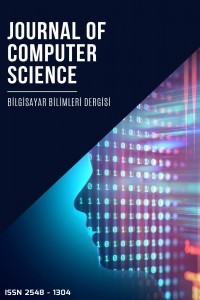IoT Botnet Verisetlerinin Karşılaştırmalı Analizi
Nesnelerin İnterneti, Botnet Saldırıları, Saldırı Tespit Sistemleri, Destek Vektör Makineleri
Comparative Analysis of IoT Botnet Datasets
___
- K. Ashton, “That ‘internet of things’ thing,” RFiD J, vol. 22, pp. 97–114, 2009, https://www.rfidjournal.com/articles/view 4986.
- Cisco, Cisco Visual networking Index (VNI) global Mobile data traffic Forecast update, 2017–2022, Cisco Systems Inc., San Jose, CA, USA, 2019.
- Broadcom, “Symantec Internet Security Threat Report 2019,” vol. 24, 2020, https://docs.broadcom.com/doc/istr-24-2019- en.
- B. Nugraha, A. Nambiar and T. Bauschert, "Performance Evaluation of Botnet Detection using Deep Learning Techniques," 2020 11th International Conference on Network of the Future (NoF), 2020, pp. 141-149, doi: 10.1109/NoF50125.2020.9249198.
- Asadi, Mehdi. (2021). Detecting IoT botnets based on the combination of cooperative game theory with deep and machine learning approaches. Journal of Ambient Intelligence and Humanized Computing. 10.1007/s12652-021-03185-x.
- S. I. Popoola, B. Adebisi, M. Hammoudeh, G. Gui and H. Gacanin, "Hybrid Deep Learning for Botnet Attack Detection in the Internet-of-Things Networks," in IEEE Internet of Things Journal, vol. 8, no. 6, pp. 4944-4956, 15 March15, 2021, doi: 10.1109/JIOT.2020.3034156.
- Apostol, I.; Preda, M.; Nila, C.; Bica, I. IoT Botnet Anomaly Detection Using Unsupervised Deep Learning. Electronics 2021, 10, 1876. https://doi.org/10.3390/electronics10161876
- Hasan Alkahtani, Theyazn H. H. Aldhyani, "Botnet Attack Detection by Using CNN-LSTM Model for Internet of Things Applications", Security and Communication Networks, vol. 2021, Article ID 3806459, 23 pages, 2021. https://doi.org/10.1155/2021/3806459
- Basati, A., Faghih, M.M. APAE: an IoT intrusion detection system using asymmetric parallel auto-encoder. Neural Comput & Applic (2021). https://doi.org/10.1007/s00521-021-06011-9
- O. Kompougias et al., "IoT Botnet Detection on Flow Data using Autoencoders," 2021 IEEE International Mediterranean Conference on Communications and Networking (MeditCom), 2021, pp. 506-511, doi: 10.1109/MeditCom49071.2021.9647639.
- Song, Y.; Hyun, S.; Cheong, Y.-G. Analysis of Autoencoders for Network Intrusion Detection. Sensors 2021, 21, 4294. https://doi.org/10.3390/s21134294
- Hussain, Z.; Akhunzada, A.; Iqbal, J.; Bibi, I.; Gani, A. Secure IIoT-Enabled Industry 4.0. Sustainability 2021, 13, 12384. https://doi.org/10.3390/su132212384
- Sahu, Amiya & Sharma, Suraj & Tanveer, M. & Raja, Rohit. (2021). Internet of Things attack detection using hybrid Deep Learning Model. Computer Communications. 176. 10.1016/j.comcom.2021.05.024.
- N. Abdalgawad, A. Sajun, Y. Kaddoura, I. A. Zualkernan and F. Aloul, "Generative Deep Learning to Detect Cyberattacks for the IoT-23 Dataset," in IEEE Access, vol. 10, pp. 6430-6441, 2022, doi: 10.1109/ACCESS.2021.3140015.
- Koroniotis, Nickolaos, Nour Moustafa, Elena Sitnikova, and Benjamin Turnbull. "Towards the development of realistic botnet dataset in the internet of things for network forensic analytics: Bot-iot dataset." Future Generation Computer Systems 100 (2019): 779-796.
- Iman Sharafaldin, Arash Habibi Lashkari, and Ali A. Ghorbani, “Toward Generating a New Intrusion Detection Dataset and Intrusion Traffic Characterization”, 4th International Conference on Information Systems Security and Privacy (ICISSP), Portugal, January 2018
- Sebastian Garcia, Agustin Parmisano, & Maria Jose Erquiaga. (2020). IoT-23: A labeled dataset with malicious and benign IoT network traffic (Version 1.0.0) [Data set]. Zenodo. http://doi.org/10.5281/zenodo.4743746
- Meidan, Y.; Bohadana, M.; Mathov, Y.; Mirsky, Y.; Shabtai, A.; Breitenbacher, D.; Elovici, Y. N-BaIoT—Network-Based Detection of IoT Botnet Attacks Using Deep Autoencoders. IEEE Pervasive Comput. 2018, 17, 12–22.
- Moustafa, Nour, and Jill Slay. "UNSW-NB15: a comprehensive data set for network intrusion detection systems (UNSW-NB15 network data set)." Military Communications and Information Systems Conference (MilCIS), 2015. IEEE, 2015.
- Ahmad, Rasheed & Alsmadi, Izzat & Alhamdani, Wasim & Tawalbeh, Loai. (2021). A comprehensive deep learning benchmark for IoT IDS. Computers & Security. 114. 102588. 10.1016/j.cose.2021.102588.
- B. Nugraha, A. Nambiar and T. Bauschert, "Performance Evaluation of Botnet Detection using Deep Learning Techniques," 2020 11th International Conference on Network of the Future (NoF), 2020, pp. 141-149, doi: 10.1109/NoF50125.2020.9249198.
- IoT-23 Veriseti (2022), https://www.stratosphereips.org/datasets-iot23, Erişim: 10 Temmuz 2022
- CTU-13 Veriseti (2013), https://www.stratosphereips.org/datasets-ctu13, Erişim: 10 Temmuz 2022
- KDD-CUP99 Veriseti (1999), http://kdd.ics.uci.edu/databases/kddcup99/kddcup99.html , Erişim: 10 Temmuz 2022
- NSL-KDD Veriseti (2009), https://www.unb.ca/cic/datasets/nsl.html, Erişim: 10 Temmuz 2022
- IoTID20 Veriseti (2020), https://sites.google.com/view/iot-network-intrusion-dataset/home, Erişim: 10 Temmuz 2022
- Scikit-learn: Machine Learning in Python, Pedregosa et al., JMLR 12, pp. 2825-2830, 2011.
- ISSN: 2548-1304
- Yayın Aralığı: Yılda 2 Sayı
- Başlangıç: 2016
- Yayıncı: Ali KARCI
Classification of Skin Cancer with Deep Transfer Learning Method
Doaa Khalid Abdulridha AL-SAEDİ, Serkan SAVAŞ
Denim Kumaşından Otomatik Yüksek Çözünürlüklü Bıyık Desen Sentezi
Emrullah ŞAHİN, Muhammed Fatih TALU
IoT Botnet Verisetlerinin Karşılaştırmalı Analizi
Analysis of Memcapacitor Based Low Pass Filter
Feras DAHROUJ, Sevgi GÜRSUL, Serdar Ethem HAMAMCI
Akademik Yazılarda Resim İntihal Kontrolü Sistemi
Muhammed Saadetdin KAYA, Kenan İNCE
5G Sistemleri için DL Tabanlı Kanal Tahmini
Fuzzy Decision Based Modeling of Rheostatic Brake System for Autonomous Land Vehicles
Semir SÜNKÜN, Berke Oğulcan PARLAK, Alper YILDIRIM, Hüseyin Ayhan YAVAŞOĞLU
Pupil Center Localization Based on Mini U-Net
Beyin Tümörü Bölütleme ve Algılamada Yeni Çekişmeli Üretken Ağ Kullanılması
